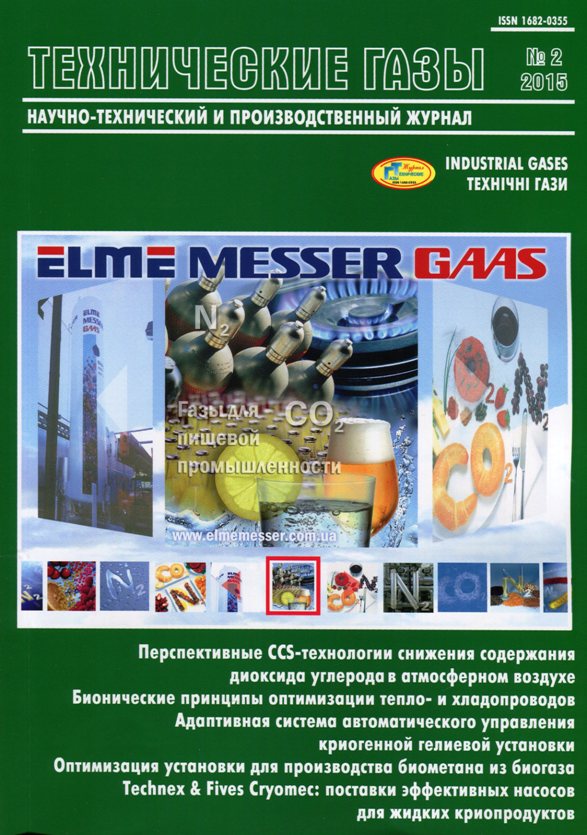PROSPECTS OF IMPROVEMENT AND WIDE SPREAD USE OF CCS-TECHNOLOGIES
DOI:
https://doi.org/10.18198/j.ind.gases.2015.0767Keywords:
Carbon dioxide, Greenhouse gas, Global warming, Absorption, Adsorption, Regeneration, Air, Concentration, Plant, Technology, Emission, Extraction of CO2 from the airAbstract
Currently, in order to reduce emissions of greenhouse gases into the environment in large thermal power plants use CCS-technology (Carbon Capture and Storage and Carbon Capture and Sequestration). This allows to reduce the growth rate of CO2 concentration in the atmosphere at a continuous increase in electricity production. In order to solve global problems need to be developed and widely adopted and other promising CCS-technology, but intended for direct removal of CO2 from the air. In this connection considered several innovative projects. The schemes, characteristics and description of the settings, realizing CCS-technology direct removal of CO2 from the air.
References
[Electronic resource]: http://www.c2es.org.
[Electronic resource]: http://www.iea.org.
[Electronic resource]: http://www.energy.gov.
Boot-Handford M.E., Abanades J.C., Anthony E.J. et al. (2014). Carbon capture and storage update// Energy & Environmental Science. — No. 7. — P. 130-189.
Caldeira K., Bala G., Cao L. (2013). Annual Review of Earth and Planetary Sciences// The Science of Geoenginee-
ring. — V. 41. — Р. 231-256.
[Electronic resource]: http://www.noaa.gov.
Lavrenchenko G.K., Kopyitin A.V. (2013). Modern technology to extract CO2 from the flue gas of thermal power plants// Tekhnicheskie Gasy. [Industrial Gases]. — № 1. — С. 40-51. (Rus.).
Lavrenchenko G.K., Kopyitin A.V. (2011). New technologies of extraction CO2 from smoke gases of thermoelectric power stations// Tekhnicheskie Gasy. [Industrial Gases]. — № 2. — P. 32-42. (Rus.).
[Electronic resource]: http://www.skyonic.com.
[Electronic resource]: http://www.aacog.com.
[Electronic resource]: http://www.carbonengineering.com.
Holmes G., Keith D.W. (2012). An air-liquid contactor for large-scale capture of CO2 from air/ Phil. Trans. R. Soc. A. — V. 370. — P. 4380-4403.
[Electronic resource]: http://www.virginearth.com/ 2015/03/carbon-engineering-breaks-ground-on-new-pilot-demonstration-plant.html.
House, K. Z., Baclig, A. C., Ranjan, M., et al. (2011). Economic and energetic analysis of capturing CO2 from ambient air// Proc. Natl Acad. Sci. USA. — V. 108. — P. 428-433.
[Electronic resource]: http://www.globalthermostat.com.
[Electronic resource]: http://www.businessinsider.com/ global-thermostat-carbon-capture-tech-2013-4.html.
[Electronic resource]: http://www.technologyreview.com/ featuredstory/531346/can-sucking-CO2-out-of-the-atmosphere-really-work.html.
Chichilnisky G., Eisenberger P. (2011). Carbon Nega-
tive Power Plants// CryoGas International. — May. — Р. 36.
Chichilnisky G., Eisenberger P. (2009). Energy se-
curity, economic development and global warming: addressing short and long term challenges// Int. J. Green Economics. — V. 3. — No. 3/4. — Р. 414-446.
[Electronic resource]: http://www.climeworks.com.
Wurzbacher J.A., Gebalda Ch., Steinfeld А. (2011). Separation of CO2 from air by temperature-vacuum swing adsorption using diamine-functionalized silica gel// Energy Environ. Sci. — V. 4. — P. 3584-3592.
Wang X., Ma X., Schwartz V. et al. (2012). A solid molecular basket sorbent for CO2 capture from gas streams with low CO2 concentration under ambient conditions// Phys. Chem. Chem. Phys. — V. 14. — P. 1485-1492.
Goeppert A., Czaun M., Prakash G.K., Olah G.A. (2012). Air as the renewable carbon source of the future: an overview of CO2 capture from the atmosphere// Energy Environ. Sci. — V. 5. — P. 7833-7853.
Goeppert A. , Zhang H., Czaun M. et al. (2014). Ea-
sily Regenerable Solid Adsorbents Based on Polyamines for Carbon Dioxide Capture from the Air// ChemSusChem. — — V. 7. — No. 5. — P. 1386-1397.
[Electronic resource]: http://www.coaway.com.
[Electronic resource]: http://www.kilimanjaroenergy.com.
[Electronic resource]: http://www.earthtimes.org/scitech/ carbon-debt-trees/1553.html.
[Electronic resource]: http://climatechange.medill.northwestern.edu/page.aspx?id=209279.html.
Babarao R., Coghlan C.J., Rankine D. et al. (2014). Does functionalisation enhance CO2 uptake in interpenetrated MOFs? An examination of the IRMOF-9 series// Chemical Communications. — V. 50. — P. 3238-3241.
[Electronic resource]: https://theconversation.com/mof-the-chart-why-a-record-breaking-surface-area-matters-9915.html.
Lin L., Kim J., Kong X. et al. (2013). Understanding CO2 Dynamics in Metal–Organic Frameworks with Open Metal Sites// Angewandte Chemie International. — V. 52. — No. 16. — Р. 4410-4413.
Wu D., McDonald T.M., Quan Z. et al. (2015). Ther-
mo-dynamic complexity of carbon capture in alkylamine-functionalized metal–organic frameworks// Journal of Materials Chemistry. A. — No. 3. — Р. 4248-4254.
McDonald T.M., Mason J.A., Kong X. et al. (2015). Cooperative insertion of CO2 in diamine-appended metal-organic frameworks// Nature. — V. 519. — No. 7543. — P. 303-308.
[Electronic resource]: http://www.nasa.gov/content/ oco-2-lifts-off-on-carbon-counting-mission.html.
Downloads
Issue
Section
License
LICENSE AGREEMENT
After receiving an article for publication as required revision scientometric databases each author directs the license agreement on the assignment and transfer of the management of copyright. Signatures of the author (s) it is desirable to seal the personnel department of the institution where the author works (authors), or the seal of the Faculty.
Revision refers to the authors one layout for proofreading. Permissible only those fixes that result in compliance with the layout of the original text of the article. Significant changes are not permitted. Layout should be sent to the editorial office within days of receipt.

